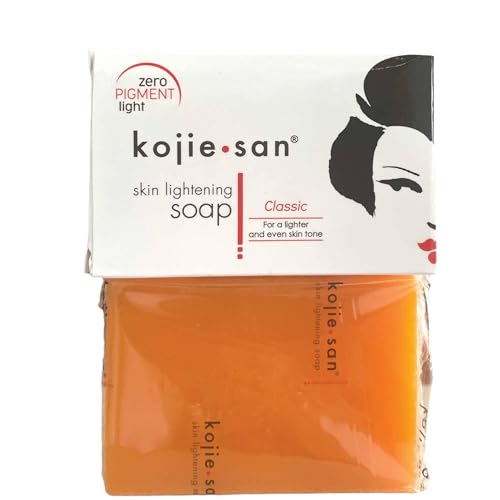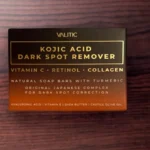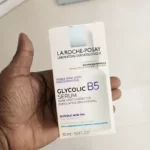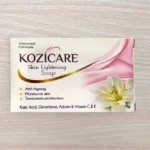Now Reading: My Sincere Review of Kojie San Skin Lightening Soap (w/ My One-Month Results)
-
01
My Sincere Review of Kojie San Skin Lightening Soap (w/ My One-Month Results)
My Sincere Review of Kojie San Skin Lightening Soap (w/ My One-Month Results)

This post may contain affiliate links. Please read our full disclosure here.
Before diving into my experience with Kojie San Skin Lightening Soap, let me give you some context. I had never used a skin-lightening product before, nor did I ever feel the need to. I’m quite comfortable with my natural wheatish skin tone. However, my new job requires me to spend long hours in the sun, and despite using sunscreen diligently, I noticed a significant tan along with unpleasant dark patches on my face, neck, and arms.
Frustrated, I turned to the internet for solutions and stumbled across Kojie San Soap. It’s a well-known product in the skin-brightening world, particularly famous for its kojic acid content—a compound originally derived from the fermentation of rice used in Japanese sake. Curious to see what all the hype was about, I decided to give it a try.
So, what exactly is kojic acid? It’s a natural derivative that works by inhibiting tyrosinase, the enzyme responsible for melanin production—the pigment that gives skin its color. By reducing melanin levels, kojic acid helps even out skin tone, fade dark spots, and improve hyperpigmentation caused by sun exposure or acne scars.
With this newfound knowledge, I felt optimistic and eager to see if Kojie San could truly make a difference for me. Here’s my detailed review based on a month of consistent use.
Packaging: Simple and Functional
The packaging of Kojie San soap is both functional and iconic. It comes in a sturdy cardboard box—not transparent (except the 3-pack)—with a bright orange and white design that features the stylized image of a Japanese woman, symbolizing the product’s roots in kojic acid fermentation. This orange-white color contrast mirrors the soap itself and creates an easily recognizable shelf presence.
Inside, the bar is sealed in plastic to prevent tampering, which is especially important because the market is flooded with counterfeit versions. The authentic soap is manufactured in the Philippines by Beauty Elements Ventures Inc. (BEVI). Genuine packaging always lists the full ingredient list (not just the first six), and it clearly states “Made by BEVI.” Look for the phrase “Zero Pigment Light Technology” on newer boxes—that’s a marker of current authentic stock.
For reference:
- The largest 135g bar features an embossed “Kojie San” stamp.
- The smaller 65g and 100g bars don’t—so don’t panic if yours isn’t stamped.
- Authentic bars are a vibrant bright orange, not a pale orange shade.
The only drawback? The soap tends to melt quickly if left in a wet dish. To make it last, store it in a well-draining soap holder or even cut it into small pieces and use one at a time. It’s a small step that saves a lot of product waste.
Ingredients: A Balanced but Potent Formula
Kojie San is a blend of natural and synthetic components, designed to combine strong brightening effects with some moisturizing support. The key active ingredient is kojic acid, which is responsible for inhibiting melanin formation. Supporting ingredients include:
- Coconut Oil – a natural emollient forming the soap’s base; adds moisture but can be slightly comedogenic.
- Glycerin – a humectant that draws moisture to the skin.
- Tea Tree Oil – adds antibacterial and antifungal benefits, helpful for body acne.
- Sodium Hydroxide (Lye) – used to saponify oils; this gives the soap its solid form but also makes it highly alkaline (around pH 9).
- Mineral Oil and Cocamide DEA – help produce the creamy lather.
- CI 15985 and CI 19140 (Yellow 6 and Yellow 5 dyes) – responsible for the soap’s vivid orange color.
The formula is paraben-free and dermatologically tested, but not hypoallergenic. The brand clearly advises a patch test before full application because mild stinging, tingling, or burning can occur. This is not unusual—it’s part of the experience with kojic acid soaps—but if irritation persists, discontinue use.

One critical insight: the soap’s alkaline base can strip natural oils and weaken the skin barrier. Even though coconut oil and glycerin are added, they can’t fully offset this effect. That’s why moisturizing afterward is non-negotiable.
Scent: Fresh, Orange, and Authentic
The scent of Kojie San is unmistakable—a fresh citrus or orange aroma that feels bright and refreshing but not overwhelming. Some users describe it as having a faint note reminiscent of sake, tying back to its Japanese fermentation roots.
The scent doesn’t linger long after rinsing, which I appreciate since I prefer mild fragrances. Interestingly, this fragrance has also become an unofficial authenticity marker—real Kojie San bars have a distinct light orange scent, whereas counterfeit ones often smell overly perfumed or like generic detergent.
For me, the subtle fragrance made daily use enjoyable without clashing with other skincare or perfume.
Effectiveness: My Four-Week Journey
Now, let’s get to the most crucial part—did it work? I used the soap for four weeks, twice a day. Here’s a breakdown of my experience:
Week 1:
I didn’t expect miracles early on, and there weren’t any. My skin felt extremely clean after washing, but also slightly tight and dry, so I immediately followed up with a rich moisturizer.
Week 2:
This was when I noticed the first visible results. The dark patches on my cheeks and neck had begun to fade slightly, and some of my acne marks looked less pronounced. My skin felt smoother to the touch.
Week 3:
By this week, the results were more noticeable. My skin tone appeared more even, and I even received a few compliments about looking “brighter.” The soap also seemed to reduce occasional body itchiness after long sun exposure, possibly due to its mild antibacterial action.
Week 4:
By the end of the month, I was genuinely happy with my results. My complexion had visibly improved, though it wasn’t “whiter”—just more balanced and healthy-looking. I didn’t experience breakouts, but I did feel some dryness and tightness on my cheeks if I skipped moisturizer.
Overall, Kojie San worked effectively for fading hyperpigmentation and mild tan, but it’s definitely not gentle. Sensitive skin types should proceed cautiously. I used it only for one to two minutes each time and never left it sitting too long on my face. Prolonged contact can cause irritation or peeling.

Size and Lifespan: Moderate but Melts Fast
The soap comes in 65g, 100g, and 135g bars, and occasionally smaller 45g ones ideal for travel. I used the 100g version, which lasted roughly three weeks with twice-daily use.
The bar is soft, which means it melts faster than harder-milled soaps. Cutting it into smaller chunks and storing the rest in a dry container helps it last longer. Also, avoid letting the bright orange lather sit on white tiles—it can stain surfaces if left unwashed.
Because of how fast it dissolves, the actual cost per use ends up being higher than it looks on paper, even though the bar itself seems affordable.
Price and Availability: Affordable but Be Alert
Pricing varies depending on where you buy it. The official U.S. distributor (KojieSanUSA.com) sells a single 65g bar for about $4.99, while bulk multi-packs on Walmart or Amazon can bring the per-bar cost down to around $2.50–$3.00.
That said, counterfeits are rampant. Fake bars can be lighter in color, smell off, or list incomplete ingredients. Always check for the manufacturer name “BEVI”, the Zero Pigment Light label, and a batch number sticker instead of a printed code. Avoid older packaging with QR or “Hidden Tag” apps—they’re outdated markers no longer used by the brand.
Online availability is good, but I recommend sticking to authorized distributors rather than random third-party sellers on open marketplaces. Authenticity anxiety is real with this soap.
Overall Rating and Final Thoughts
After a month of steady use, I’d give Kojie San 4 out of 5 stars. It genuinely delivers on its claims of lightening dark spots and evening out skin tone, but it’s not for everyone. The dryness and high alkalinity can be a challenge for sensitive or already dry skin.
Still, for the price and performance, it remains one of the most effective kojic acid soaps I’ve tried. Its results are real, not exaggerated. I appreciate that it’s paraben-free and manufactured under GMP standards, though I do wish the brand were more transparent about its cruelty-free and environmental policies, which are still unclear.
If you’re looking for an affordable and proven soap for hyperpigmentation, Kojie San is worth trying—just pair it with good sun protection and moisturizer, and ensure it’s authentic before buying.
Tips for Best Results and Final Words
- Do a patch test first. It’s a strong formula and can cause a tingling or stinging sensation.
- Use sunscreen daily. Kojic acid increases sun sensitivity.
- Moisturize immediately after use. This keeps the skin barrier healthy.
- Avoid leaving the lather on too long. One to two minutes is plenty.
- Buy only from official sources. Counterfeits are a serious problem.
With the right care, Kojie San Skin Lightening Soap can be a powerful ally in reducing hyperpigmentation and restoring your natural glow—just handle it with the respect it deserves.


















